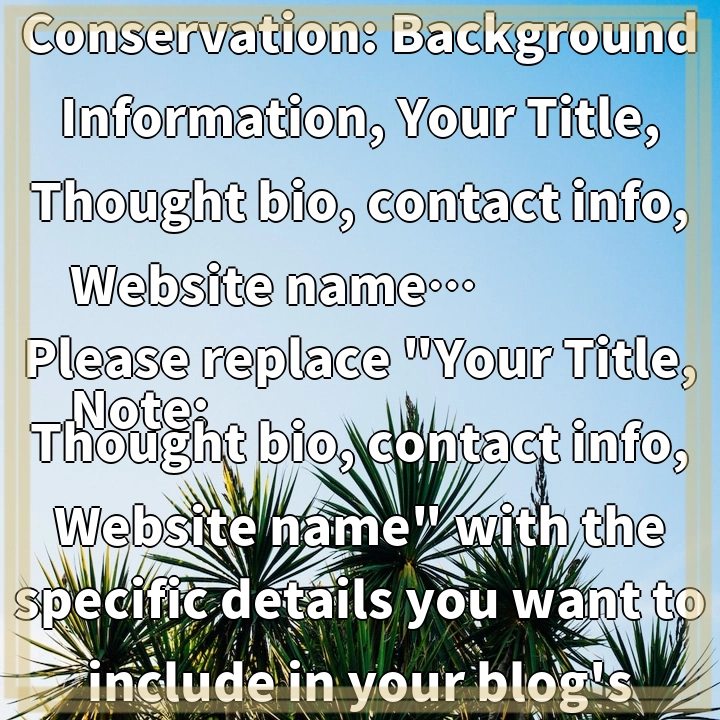
Exploring Wildlife Conservation
Background Information:
Wildlife conservation is a crucial field dedicated to protecting and preserving the diverse range of species and ecosystems found in our world. It involves the management and conservation of wildlife habitats, the promotion of sustainable practices, and the prevention of species extinction. With the alarming rate of habitat destruction, poaching, climate change, and human-wildlife conflicts, wildlife conservation has become a pressing issue demanding immediate attention.
What it is:
Wildlife conservation encompasses a wide range of activities and initiatives aimed at safeguarding the welfare and survival of wildlife species. It includes the establishment and management of protected areas, such as national parks and wildlife sanctuaries, where animals can thrive in their natural habitats. It also involves monitoring and research to understand wildlife populations, behavior, and ecological interactions.
Additionally, wildlife conservation advocates for the preservation of biodiversity and the restoration of degraded habitats. This may involve the implementation of sustainable land-use practices, the prevention of pollution, and the conservation of key ecological corridors to ensure the connectivity between different wildlife populations.
Real-world Problems:
Despite the efforts being made, wildlife conservation faces numerous challenges in today’s world. One of the main problems is habitat loss due to deforestation, urbanization, and agricultural expansion. As human activities continue to encroach upon natural areas, wildlife populations are losing their homes and struggling to find suitable habitats.
Poaching and illegal wildlife trade pose another significant threat to wildlife conservation. The demand for animal parts, such as ivory, rhino horn, and exotic pets, drives the illegal killing and trafficking of endangered species. This illicit activity not only decimates populations but also disrupts ecosystems and undermines conservation efforts.
Climate change is yet another pressing issue affecting wildlife conservation. Rising temperatures, altered precipitation patterns, and changing habitats disrupt the delicate balance of ecosystems, risk altering migration patterns, and threaten the survival of numerous species.
Human-wildlife conflicts also exacerbate the challenges faced by wildlife conservation. As human populations expand and encroach upon natural areas, conflicts arise due to competition for resources, damage to crops and livestock, and threats to human safety. Finding sustainable solutions that balance the needs of both humans and wildlife is crucial for effective conservation.
Note: Please replace “Your Title, Thought bio, contact info, Website name” with the specific details you want to include in your blog’s byline.

Solutions for Wildlife Conservation
Protecting and conserving wildlife requires a collective effort and a combination of strategies. The following are potential solutions to address the challenges outlined:
1. Habitat Conservation and Restoration
Preserving and restoring natural habitats is vital for the long-term survival of wildlife. This involves establishing protected areas, creating wildlife corridors, and promoting sustainable land-use practices to minimize habitat destruction. Collaborations between governments, NGOs, and local communities are crucial for successful habitat conservation.
2. Anti-Poaching and Wildlife Trade Regulations
Efforts must be made to combat poaching and illegal wildlife trade. This includes strengthening law enforcement, imposing stricter penalties for offenders, and raising awareness about the consequences of wildlife trafficking. International cooperation and public support are essential to tackle this global issue effectively.
3. Climate Change Mitigation and Adaptation
To address the impact of climate change on wildlife, it is crucial to reduce greenhouse gas emissions and promote sustainable practices. This involves transitioning to renewable energy sources, protecting carbon-rich ecosystems like forests and wetlands, and promoting climate-resilient strategies in conservation planning.
4. Community Engagement and Education
Involving local communities in wildlife conservation efforts is vital for success. Engaging communities through education and awareness programs can foster a sense of ownership and responsibility towards wildlife and their habitats. It is essential to empower communities to become active participants in conservation initiatives.
5. Sustainable Development and Livelihood Options
Addressing human-wildlife conflicts requires finding mutually beneficial solutions. Implementing sustainable development practices that provide alternative livelihood options for local communities can help reduce conflicts and promote coexistence between humans and wildlife.
Note: Please replace “Your Title, Thought bio, contact info, Website name” with the specific details you want to include in your blog’s byline.















